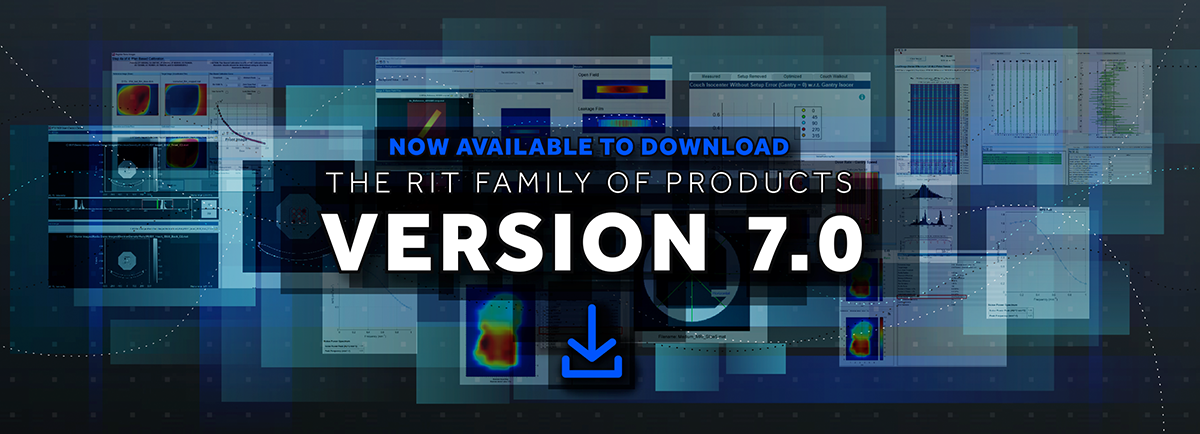What's New in V6.9
THE RIT FAMILY OF PRODUCTS: Version 6.9
Version 6.9 of the RIT Family of Products was released on October 15, 2020.
Machine & MLC QA
60-Leaf MLC Support for Varian RapidArc® Tests
RIT’s analysis for Varian RapidArc Test 2: Dose Rate & Gantry Speed and Varian RapidArc Test 3: Leaf Speed now includes expanded support for 60-leaf HD MLCs. In addition to the traditional 40-leaf MLC, RIT’s software will now automatically analyze the larger 60-leaf MLC from within the same analysis window, allowing for expanded support of a wider range of Varian LINACs.
These routines also feature new functionality: The SID is automatically extracted from DICOM images, and the ROI and leaf template dimensions are automatically configured for 40 and 60-leaf MLCs.
RapidArc® is a registered trademark of Varian Medical Systems, Inc.

Patient QA
Enhanced TomoTherapy® Registration
Easily perform exact dose comparisons for TomoTherapy patient QA. The newly enhanced analysis uses a TomoTherapy plan, a dose map, and a film to determine position and dose accuracy, using the red or green lasers. This routine supports the following Accuray treatment planning systems:
- TomoH V 5.1.3 - Build 5.1.3.9
- Precision® 1.1.0.0 - Build 56037
- Precision® 1.1.1.1 - Build 11
Support for the red and green lasers is offered for the following treatment planning systems:
- Precision® 2.0.0.0 - Build 64
- Precision® 2.0.1.0 - Build 14
- Precision® 2.0.1.1 - Build 5
- Precision® 3.0.0.0 - Build 68
- Precision® 3.1.0.0 - Build 42
- Precision® 3.2.0.0 - Build 30

Please note: This list has since been updated for the current version. For the most up-to-date list, please click here.
TomoTherapy® and Precision® are registered trademarks of Accuray, Inc.
Imaging QA/QC
Couch Placement Phantom Analysis
In addition to the phantoms being placed on an imager, RIT software can now analyze specific phantoms when placed directly on the couch. The phantom’s magnified dimensions are automatically calculated from the phantom size. Placing the phantom on the couch provides an analysis that is closer to realistic patient positioning, while placing the phantom directly on the imager provides clearer images. This update provides physicists for more setup options when performing phantom analyses. RIT can now analyze the following phantoms with direct couch placement:
- EPID: PTW EPID phantom, used for therapeutic EPID QC.
- kV: The Primus®-L phantom, used for diagnostic kV imaging.
Primus® is a registered trademark of IBA.


Enhanced CATPHAN® Low-Contrast Module Features
The CATPHAN Low Contrast module now allows for a “CNR-only” analysis at the large contrast target object in the phantom. The Contrast-to-Noise (CNR) ratio analysis is readily accessible, without needing to perform other extraneous analyses. This excludes the Low Contrast object detection from the analysis, which may not be necessary for some QA specifications.
Easily select the “CNR Only” analysis type to analyze the CNR between the reference region and the local background region of a CATPHAN Low Contrast image. The routine’s algorithm has also been updated to provide enhanced object detection, providing greater flexibility for physicists to choose which QA specifications are most appropriate.
CATPHAN® is a registered trademark of The Phantom Laboratory.
Added Support for Varian & TG-58 Acceptance Criteria for Las Vegas EPID Phantom Analysis
RIT customers can enjoy increased flexibility on their preferred QA guidelines when analyzing images from the Las Vegas EPID phantom. In addition to the RIT Legacy guideline, you can now utilize the newly added TG-58 or Varian QA guidelines. The QA guideline determines which of two tests will be performed in the analysis:- Contrast and Spatial Resolution
- Image Quality


Diagnostic TOR-18 Phantom Analysis
RIT has enhanced our support for diagnostic TOR-18 phantom analysis on images captured with fluoroscopy machines. RIT previously supported TOR-18 kV therapeutic phantom analysis, but now, diagnostic physicists can analyze TOR-18 phantom images from fluoroscopy machines with resolutions higher than previously capable.
Other
DICOM Anonymizer
Use RIT’s new DICOM Anonymizer feature to automatically anonymize any patient-specific data imported from any DICOM files. Easily keep in compliance with patient privacy requirements with this easy-to-use feature, newly added to all RIT product packages.




